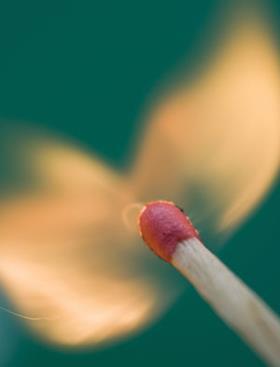On screen chemistry with Jonathan Hare

In Escape from Alcatraz, Clint Eastwood plays Frank Morris, a convict in the infamous maximum security island prison off San Francisco. The film is based on the true story of Morris' escape from the prison. He uses a small nail clipper to pick away the plaster/cement off his prison wall to make a hole large enough for him to escape through.
Morris steals a spoon from the canteen to dig the hole and apparently joins the handle to the end of a nail clipper to make a longer pick. He carefully removes some match heads to make up a pyrotechnic mixture, and places this in a tin can under the join of the spoon and clippers. Then he scrapes off pieces of a coin (a dime) onto the metal joint before lighting the matches. After the flare has died down and the metal has cooled he tries the joint out. It holds, so he continues, but could he really have 'welded' the two pieces of metal together using matches?
The temperature produced by burning matches is quite high, ca 600-800°C, but not nearly enough to melt steel or iron (the spoon and nail clippers).
The film is set in the 1960s and before 1965 dimes were made mainly of silver (ca 10 per cent copper and 90 per cent silver), which melts at a lower temperature than steel or iron. Morris chips off bits of the coin onto the joint so perhaps he was using it as a silver solder. However, you need a chemical flux to get a good solder joint. When flux is heated it reacts with metal oxides, reducing them to the pure metals, which helps the solder flow. You can't get a decent solder joint without it.
Our prisoner might have been able to make a flux from cleaning chemicals he came across doing his chores. Borax (sodium tetraborate) was a common detergent at the time and works as a silver flux when mixed with water.
In the TV series Hollywood science we tried to reproduce this technique but found that the heat generated by the matches was too short-lived to produce enough of a temperature rise to melt the silver solder. We even tried wrapping the joint in foil but it failed. It is conceivable that Morris could have kept adding matches to provide continuous heating but surely the guards would have smelt (and seen) the smoke from such a fire.
Perhaps the combination of a small hole he had already made and the windy island location provided the suction required to extract the smoke produced by the reaction. This could have provided a flow of air over the reaction to enhance the combustion (like bellows in a furnace) and thus raise the temperature so that he could solder the joint.
Dr Jonathan Hare, The CSC Centre, Chemistry Department, University of Sussex, Brighton BN1 9ET
This article was originally published in The Mole









No comments yet